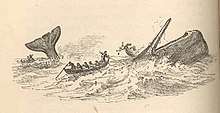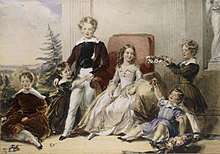Elhanan Bicknell
Elhanan Bicknell (21 December 1788 – 27 November 1861) was a successful London businessman and shipowner. He used his wealth as a patron of the arts, becoming one of the leading collectors of contemporary British art.
.jpg)
Early life
Elhanan Bicknell was born 21 December 1788, in Blackman Street, London, the son of William Bicknell, serge manufacturer, and Elizabeth Bicknell, nee Randall, of Sevenoaks, Kent.[1]
His father had attended John Wesley's school at Kingswood, Bristol, and entertained Wesley in Blackman Street when he came to preach at Snow's Fields in Southwark. Another minister who was a family friend was Elhanan Winchester, author of Universal Restoration; after whom the son was named. William Bicknell bought the copyright of this work in the year of his son Elhanan's birth, and on finding that he had made money on the deal, gave it back to the author in 1789.[1]
Elhanan Bicknell was educated by his father, who, having established a school at Ponder's End in 1789, when Elhanan was an infant, removed it to Tooting Common in 1804; and there among Elhanan's schoolfellows, was Thomas Wilde, afterwards Lord Chancellor Truro.[1]
In 1808 Bicknell was sent to Caus, near Shrewsbury, to learn farming; but at the end of a year this project was abandoned.[1]
In business

Bicknell returned to London late in 1808 and soon after he joined a business run by his uncle, John Walter Langton (1746-1822). Langton had established himself as a tallow chandler at Newington Butts , about a mile south of London Bridge, by 1788.[2] Bicknell became a partner in the business about 1809 and the following year he married his cousin, Langton's daughter Hannah.[3] She was the first of his four wives with whom he had a total of thirteen children. The business partnership was also productive and saw the firm become the leading oil merchants and spermaceti refiners in London by 1835.[4] Bicknell was also part-owner of a number of South Sea whaling ships.
There were setbacks along the way. In 1820 a major fire broke out in the boiling works and destroyed much of the building, causing £2,000 in damages.[5] A severe thunderstorm in 1846 produced large hailstones that smashed the windows in the buildings in the compound. It was reported in the press, "the extensive premises of Langton and Bicknell have scarcely a pane left."[6] The business was located opposite St Mary's Church near Elephant and Castle. A friend and close business associate there at Newington Butts was fellow oil merchant and shipowner, Thomas Sturge.
About 1835 Bicknell anticipated agitation for the repeal of the navigation laws would injure his business interests, yet he magnanimously supported the movement, together with the abolition of all protection; and when the crippling of his undertakings and his income came, he accepted it.[1]
Langton & Bicknell, as a business, continued to operate till 1907, long after the death of the original partners.[7]
Collector

Bicknell occupied a large house at Herne Hill, Surrey, from 1819. In 1828 he began what became a major collection of pictures by contemporary or recent British artists. By 1850, he had collected some of the works of Thomas Gainsborough, J. M. W. Turner and numerous others including David Roberts, Edwin Landseer (such as Doubtful Crumbs), George Clarkson Stanfield, Thomas Webster, William Collins, William Etty and Augustus Wall Callcott.[8] He became personally acquainted with most of the artists, entertained them in his home and paid them well. The house did not have a Long gallery, so Bicknell placed these works, with pieces of sculpture such as Edward Hodges Baily's Eve at the Fountain, throughout the rooms, and opened his house to art connoisseurs.[1] Gustav Friedrich Waagen published a description and listing by room in his Treasures of Art in Great Britain.[9] A visitor who came to see the collection in 1857 said, "It could not have been formed in better taste."[10] This may have been John Ruskin who lived nearby and made regular visits to see the paintings of, "my always kind neighbour."[11]
Published comments by Ruskin and other art experts made Bicknell's collection well known and may have contributed the high prices it fetched when broken up after his death. A contemporary writing about the high prices paid for fine art in the 1860s said, "the fancy prices quoted are nearly all for pictures from famous collections; and some for the Bicknell pictures, for example, would almost suggest that as much was due to the name of the collector as the merit of the picture."[12]
Bicknell bought many of Turner's finest works before Ruskin's advocacy brought the artist to public prominence. In 1841 he paid Turner £250 for a painting of gondolas in Venice. That painting, Guidecca, La Donna Della Salute and San Giorgio (1840), changed hands in 2006 for US$35.8 million, setting a new record for a British work of art sold at auction.[13]
Unitarianism
In politics and in theology Bicknell was an advanced liberal. He supported Unitarianism, was a principal contributor to the building of the Unitarian chapel at Brixton, and gave to the British and Foreign Unitarian Association.[1] (The chapel on Effra Road was destroyed in the Blitz in 1941.[14]) He was a member of the committee for the erection of, and a substantial donor to, the 1820s campaign for South Place Unitarian Chapel under William Johnson Fox, which evolved into today's Conway Hall Ethical Society.[15]
He was a member of the Worshipful Company of Vintners, one of the oldest Livery Companies in London, serving at various times as Warden and Master.
Later life
One of his minor business ventures was a partnership with London print dealer Joseph Hogarth. The association began in the 1830s and continued into the early 1850s. During that time Hogarth transitioned from a print retailer to a publisher of high-quality art prints.
His business acumen and reputation saw Bicknell being invited to become a partner in the major engineering firm Maudslay; but he turned down the offer. In 1859 his health began to fail, and he retired from business. He passed the rest of his time at Herne Hill, where he died 27 November 1861, aged 72. He was buried at West Norwood Cemetery.[1]
Legacy
Bicknell's will was proved under £350,000. Among the executors were two of his sons, Henry Sandford and Percy.[16]
While Bicknell had wanted to leave his collection to the nation, the family decided otherwise. His pictures, which numbered 122 at his death, were sold at Christie's auction rooms, realising a sum of nearly £80,000. Richard Seymour-Conway, 4th Marquess of Hertford bought about one-third for his own gallery.[1]
Family

In 1829 Bicknell married Lucinda Browne, a sister of Hablot Knight Browne (aka Phiz, the illustrator of Charles Dickens). He left a large family by his various marriages, and some of his sons (one of whom married the only child of David Roberts, R.A.), in succeeding to his fortune, made names for themselves in the arts, archaeology, botany, travel, and reform.[1]
- Elhanan Bicknell, the eldest son, died in 1860 at age 46.[17]
- Herman Bicknell (1830–1875), orientalist, was the third son.[18]
- Algernon Sidney Bicknell (1832-1911) soldier, traveller and writer.[19]
- Clarence Bicknell (1842-1918), vicar, botanist, archaeologist and author.[20]
- Henry Sanford Bicknell[21] (1818-1880)
- Mrs Ada Berry (nee Bicknell) (1831-1911)[22]
- Edgar Bicknell (1834-1886)
- Percy Bicknell (1836-1911)
- Matilda Bicknell (1838-1858)
- Lucinda Constance Bicknell (1840-1902)
Notes
- Stephen, Leslie, ed. (1886). . Dictionary of National Biography. 5. London: Smith, Elder & Co.
- London Gazette, 23 December 1788, Issue No.13054, p. P.638.
- Selby Whittingham, “Bicknell, Elhanan (1788-1861) art patron and businessman,” Oxford Dictionary of National Biography
- "Mark Howard, "Elhanan Bicknell, oil merchant and shipowner."" (PDF).
- The Gentleman's Magazine and Historical Chronicle, from July to December 1820 p.176.
- Glasgow Herald, 7 August 1842.
- Valerie Lester, Marvels: the life of Clarence Bicknell, botanist, archaeologist, artist, Matador, Knibworth Beauchamp, 2018, p.188.
- Dianne Sachko Macleod, “Art collecting and Victorian middle-class taste,” Art History, 10 (3) September 1987, pp.336-7
- Waagen, Gustav Friedrich; Graves, Algernon (1854). Treasures of Art in Great Britain: Being an Account of the Chief Collections of Paintings, Drawings, Sculptures, Illuminated Mss., &c., &c. 2. J. Murray. pp. 349–54. Retrieved 22 December 2017.
- ”Visits to private galleries of the British School - The collection of Elhanan Bicknell, Esq., at Herne Hill,” The Art-Journal, 1857, Vol III, p.10.
- John Ruskin & Sir Edward Tyas Cook, Turner at the National Gallery and in Mr Ruskin’s Collection, G. Allan, London, 1903, p.390.
- "Art in the auction room - Prices," London Society, An illustrated magazine of light and amusing literature for the hours of relaxation, Vol IX, London, 1866, p.258.
- The Times, 7 April 2006, p.25.
- "Effra Road Chapel". www.brixtonunitarians.org. Retrieved 29 April 2018.
- "The building of South Place Chapel, 1821 - Conway Hall". Conway Hall. 21 November 2013. Archived from the original on 2 August 2018. Retrieved 2 August 2018.
- The Law Times. Office of The Law Times. 1862. p. 154.
- The Monthly (alphabetical) record of births, deaths, & marriages (and Alphabetical list of estates of deceased persons). p. 23.
- s:Bicknell, Herman (DNB00)
- “The memoirs of Algernon Sydney Bicknell at The Keep (East Sussex archives)”
- "Search Results - Oxford Dictionary of National Biography".
- British Library manuscript collection catalogue entry
- Marcus Bicknell, “Margaret and Edward Berry”
External links
- Attribution
![]()